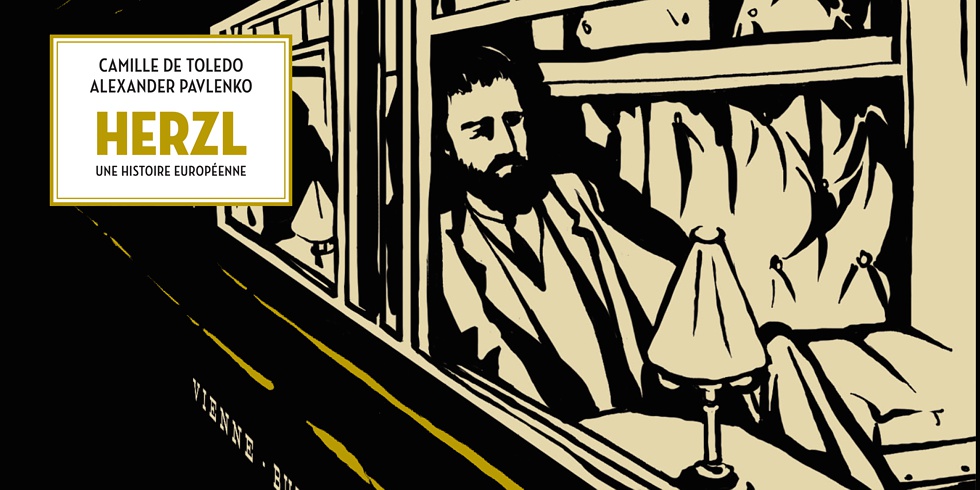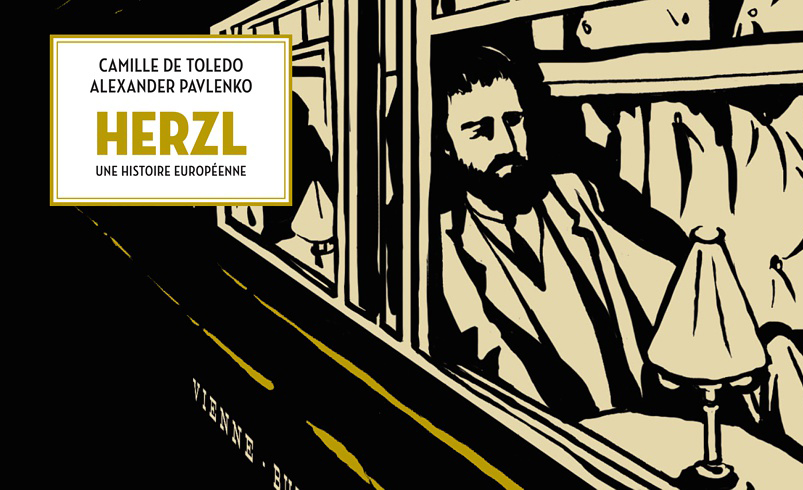Four decades after Art Spiegelman began publishing a comic-strip serial about the Holocaust, later released in book form as Maus, the exploration of serious subjects by means of cartoon panels and word balloons no longer has the capacity to surprise. Still, a 350-page graphic novel dealing with Theodor Herzl (1860-1904), the foundational figure of modern political Zionism, is hardly an everyday sight. And yet there it is, not only in its original French—Herzl: une histoire européenne—but now also in a Hebrew edition.
The book is the creation of Camille de Toledo, a French writer claiming paternal descent from Spanish Jews, and the Russian-born illustrator Alexander Pavlenko. Hardly the first comic-book meditation on Jewish history and identity, it joins the work of the French illustrator Joann Sfar and occupies a place on a growing shelf of first-person American Jewish chronicles of unhappy childhoods, first trips to Israel, and the like. But it is the first extended treatment in this form of a major Jewish historical figure, or of the nature of the Zionist project. The pity is that—for reasons worth exploring—it is an egregiously poor one.
De Toledo and Pavlenko recount much of the basic biography of their subject while inventing or imagining a few details, including a visit to a brothel by Herzl in the company of his fellow Viennese Jewish playwright Arthur Schnitzler. Strangely, though, the biography is mostly confined to the last third of the book, in which both Herzl and Zionism are seen through the eyes of a meek Jewish photographer named Ilia Brodsky—an obvious stand-in for de Toledo—whose own story forms the book’s narrative framework.
It is thus with Ilia that we begin our 350-page trek, following him from his 19th-century childhood in a Russian shtetl to Vienna and then to London. In 1884, he first catches a glimpse in Vienna of the young Herzl, a dashing young playwright and journalist still a decade away from his transformation into the inspired prophet of the reborn Jewish nation. Impressed, Ilia spends the rest of his own life reading everything by or about the Zionist founder-to-be that he can get his hands on.
What is it that so fascinates Ilia, and his creator, about the great man? Oddly, little having to do either with the Jews themselves or with their national awakening. In this graphic novel, traditional Judaism is portrayed as repellent and moribund. The shtetl of Ilia’s birth is a caricature, populated by a dour “bird people . . . a multitude of shadows and faces that no longer looked at heaven.”
Similarly sparse—notwithstanding stray references to the Austrian Jewish author Joseph Roth, to Sholem Aleichem’s Tevye the Dairyman, or to the socialist press in London—is any real evidence of the explosive, multilingual effusion of modern Jewish culture that helped provide the background to Zionism’s emergence. Modern Hebrew literature, of cardinal importance in this connection, seems to be terra incognita to Ilia and his creator. On Ilia’s bookshelves it’s possible to make out the presence of volumes by S.Y. Agnon, Yaakov Fichman, and others, but these are merely ornamental, playing no role in the story and shedding no light on why Theodor Herzl should have upended his life to devote himself to the creation of a Jewish state—the very question that preoccupies Ilia’s every waking day.
Nor, for all of his obsessive peregrinations and fact-finding travels, does Ilia—a bargain-basement version of the familiar Jewish type of the luftmensch—ever visit the growing Jewish communities in Palestine itself or exhibit any curiosity about the Jewish state-in-the-making there, the real-life correlative of Herzl’s vision. To the contrary: “What is this neurosis about land?” he asks. “Why do we have this difficulty living in the world without tying ourselves to land?” And it is not only land that Ilia has difficulty fathoming; it is people as well. He has scarcely any contact with other Jews, or indeed with humans of any sort apart from his sister (who leaves for America early on) and a few other occasional passers-through.
Eventually, we learn, Ilia does hit on an explanation for Herzl’s life-changing act. It certainly “wasn’t due to the Land, or the Nation, or his obsession with the State.” Rather, Herzl demonstrates “the role played in history by Dream . . . how the dream forges the future.” But this vague and breezy theory, which at least has the virtue of echoing Herzl’s own famous formulation (“If you will it, it is no dream”), is then rejected by Ilia in favor of another, ostensibly deeper one.
The mystery of Herzl’s politics, it turns out, is to be explained by the loss of his Hungarian childhood and especially of his sister Pauline, who died of typhus in 1878 and was buried in their native Pest. Zionism, the narrator intones, was the compensation for that loss: “one body substituted for another . . . the body of the Jews, of the dreamed-of, hoped-for Jewish nation, replac[ing] the body of his sister.” The Zionist project itself, we are instructed, owes everything to “a tomb in Pest.”
In light of such solemn psychobabble, one is grateful to have been spared de Toledo’s speculations on Herzl’s bathroom habits.
As with many a graphic novel, the ambition in Herzl is novelistic, but the result is cartoonish in every sense of the word. For this failure one cannot blame Alexander Pavlenko, de Toledo’s clearly talented collaborator—whose art, however, all too faithfully reflects the sterility of the book’s ideas. Pavlenko has drawn the work in black and white, with a dispiriting background rendered in an orange wash the color of children’s aspirin. Rather than interacting, text and image are largely disconnected from each other. Page after page offers chunks of quotations from Herzl’s writings, juxtaposed with random and generic images of shadowy Viennese streets, murky silhouettes, and blank faces. The characters are endowed with little visual individuation.
In a graphic novel, this static quality, broken by only a few stirrings of something more alive (as in the brothel scene or, in Pavlenko’s art, by a momentary visual echo of the brilliant fin-de-siècle Zionist illustrator Ephraim Moses Lilien), is all but fatal.
And this brings us to the larger question I raised early on: how many of the failures of this book can be ascribed to the form in which it is cast, and are shared by others of the same genre? To answer that question means confronting some hard truths not only about Jewish graphic novels in particular but about graphic novels in general.
Most such works, despite the rise of the form to prominence and respectability, and its proliferation in school and university curricula, are mediocre. While Spiegelman’s Maus and the satire of Jules Feiffer, to mention another elder Jewish statesman of the form, were pioneering, they do not especially reward rereading, and the rapidly dating work of their creators’ epigones has long since landed on the ash heap of neurotic American Jewish kvetching.
In large part, the problem inheres in the contradictory nature of the form itself. The great merit of novels lies in their complexity, their imaginative and social capaciousness; the great merit of the comic book lies in its reductiveness, its compression, and its visual immediacy. And then there is the issue of relative talent. With very few exceptions, one can define the typical graphic novel as a marriage of writing not good enough to be published as a book with illustration not good enough to be exhibited as art.
There are, of course, long-form comics that in a variety of ways rise smartly to the challenge. The Franco-Belgian tradition, from George Remi’s The Adventures of Tintin to the art of Philippe Druillet and Jean Giraud (Moebius), often employs an episodic and picaresque approach, generating a sense of expansiveness by adding ever more adventures and a sense of cinematic depth through crisp illustrations and illusions of scale. The Canadian Dave Sim, in his 6,000-page Cerebus, has attempted a comic-book parallel to the pacing and psychological resonance of the 19th-century European novel.
For its part, the best American serial art tends to stay close to the demotic energy of its comic-book roots. And yet even so, and with all due respect to the wondrous creations of George Herriman, Jack Kirby, and Jaime Hernandez, to name some of my favorites, the sole instance of the genre that seems to me to rank with the greatest works of American culture is the modest, four-panel perfection of Charles Schulz’s Peanuts.
And what about the Jewish case? One senses the form’s inherent tensions even in so compelling a book as Yudise’ah (“Jewdyssey”), a rendering of The Odyssey as a Holocaust story by the Israeli illustrator Shay Charka. Charka’s roughly drawn graphic novel is thought-provoking as a whole, but little in it is as powerful as a single panel in which he refashions the story of the witch Circe, who turns Odysseus’ men into animals, as a protest against the dehumanization of Jews in anti-Semitic illustration. Here, “Circe” is a well-meaning Polish woman, and her sorcery dramatizes the effect of toxic anti-Semitism on the work’s Jewish protagonist.
The point, though, is that Charka delivers more in that single panel than in the book’s longer sections of narrative. Relevant here is that he has also succeeded strikingly in two graphic versions of stories by the great Hebrew writer S. Y. Agnon, works that allow him to deploy the art of illustration as a knowledgeable and imaginative kind of midrashic commentary on—notably—shorter texts.
As for those Jewish graphic novelists who, like the author of Herzl, hold big opinions and firmly fixed attitudes toward Zionism, Israel, and the Jews but possess neither the knowledge nor the imagination to rest them on, little more need be said. Hungering for Jewish depth and artistic vitality, one is fed a diet of intellectual black-and-white, too often in the most tedious of grays.
More about: Arts & Culture








